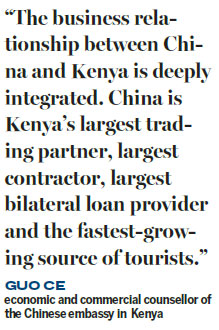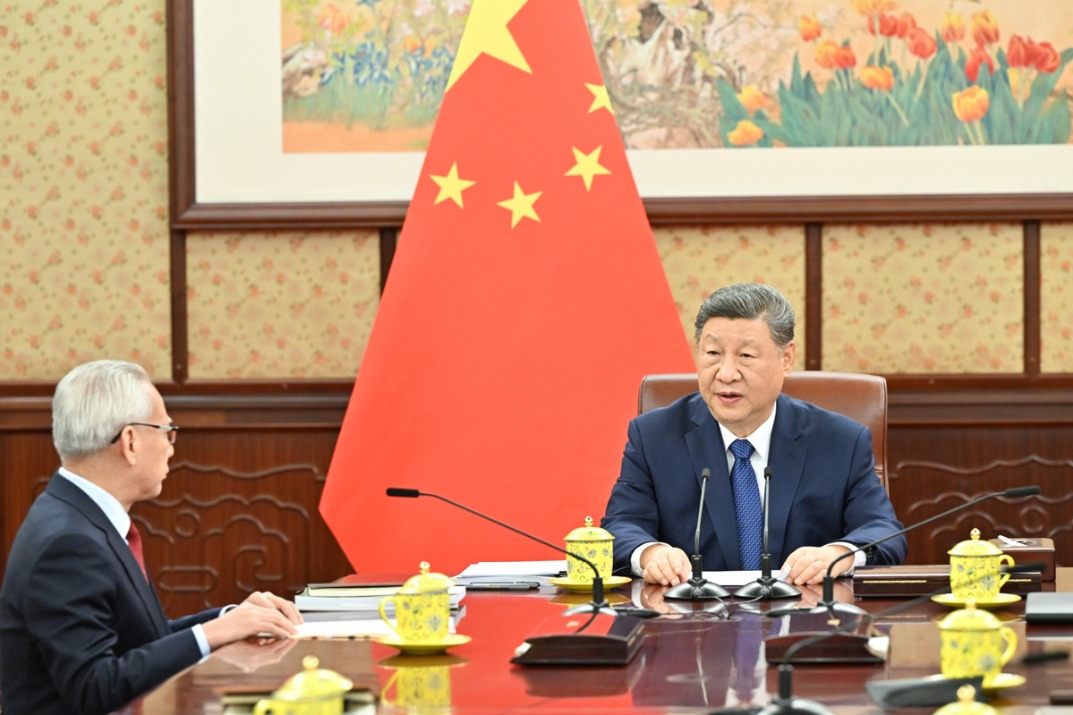Explorer charted course for friendship

Hundreds of years after Chinese first visited Kenya, cooperation between the two countries continues with major projects
In the year 1415, Chinese navigator Zheng He led a fleet for his fourth far-reaching ocean voyage and arrived in Kenya, on the east coast of Africa.
Chinese local governments sent envoys following Zheng He's visit, marking the first official contact between China and Africa.
Afterward, the Ming Dynasty (1368-1644) explorer's fleet again visited Kenya and other parts of Africa, sharing China's philosophy of peace and prosperity with these countries.

Frequent contacts between China and Africa boosted the prosperity of the ancient Maritime Silk Road routes. Uhuru Kenyatta, president of Kenya, says that Zheng He's visits sowed the seeds of friendship between the two countries, and Kenya has been an important link between China and Africa ever since.
It is now 600 years since Zheng He's fifth visit to Kenya in 1417.
Earlier this month, Kenyatta participated in the Belt and Road Forum for International Cooperation in Beijing, showing Kenya's support for the Belt and Road Initiative that President Xi Jinping proposed in 2013.Kenyatta said he recognized the bright future that the initiative will bring to the world and offered to connect Kenya's own development plan with the initiative to push cooperation to a higher level.
The business relationship between China and Kenya is deeply integrated. China is Kenya's largest trading partner, largest contractor, largest bilateral loan provider and the fastest growing source of tourists. For successive years, Kenya has been the African country in which China has invested the most. Of more than 30 flagship projects by the Kenyan government, about half are being carried out jointly with China.
These achievements have come about less than four years after President Xi and President Kenyatta decided to build their comprehensive partnership in 2013.
If we follow the locations that Zheng He's fleet visited, from the south to the north of Kenya's coast, we can find many China-Kenya projects.
The first stop is Mombasa, where the major project is the Mombasa-Nairobi Standard Gauge Railway, being built by the China Road and Bridge Corp. It is the biggest infrastructure project to be undertaken in Kenya since its independence and is recognized as the "Project of the Century". It also forms an important part of the East Africa railway network. The railway has adopted China's standards, equipment, technology and management methods.

By the end of 2016, the construction of the railway had created 42,000 jobs in Kenya, including 8,976 technicians and 8,790 management staff, accounting for 42.3 percent of all jobs in Kenya. The project will be completed by the end of May and will become a major part of the Belt and Road Initiative. This railway will not only reduce transportation costs but will also boost the development of the industrial parks and special economic zones along its route.
The second stop is Malindi, where the big project has been the modernization and strengthening of the CAMCE Kenya Power Distribution System, carried out by China CAMC Engineering Ltd. The project was funded with preferential loans from China and was completed in 2015. It has ensured the stable supply of electricity in coastal regions since then and has benefited 300,000 people. This is only one small example of how the Chinese government has been supporting Kenyan energy projects financially. Now, Chinese companies are accelerating investment in clean energy, including wind power, and solar and geothermal energy. In this sector, Chinese companies will change their role from being contractors to investors.
The third stop is Lamu, which is also where the descendants of ZhengHe's crew members still live. The landmark project here is Lamu Port, contracted to China Communications Construction Corp. This project is important for the development of the northern part of Kenya and for connecting it to Ethiopia and South Sudan. It is also a flagship project in the Kenyan government's 2030 Plan.
The building of the north corridor will connect the Lamu Islands with the central town of Isiolo, which has rich wildlife resources and the country's biggest inland water, Lake Turkana. This will boost the development of tourism and benefit logistics with South Sudan and Ethiopia. Economic development in these regions will also help neighboring regions fight terrorism.
So, in just three stops we can see the extent of China and Kenya's cooperation on infrastructure and connectivity. From being a stop on the ancient maritime silk road, Kenya has developed into an important supporter of China's Belt and Road Initiative. It will also become the first stop for Chinese companies entering Africa.
The author is the economic and commercial counsellor of the embassy of the People's Republic of China in the Republic of Kenya. The views do not necessarily reflect those of China Daily.
(China Daily Africa Weekly 05/26/2017 page13)
Today's Top News
- Opening of new gateway can help foster global economic and trade cooperation
- The farmer, the snake and Japan's memory hole
- Crossing a milestone in the journey called Sinology
- China-Russia media forum held in Beijing
- Where mobility will drive China and the West
- HK community strongly supports Lai's conviction






























